Detailed Business Finance Performance Analysis of T Shirt plc
VerifiedAdded on 2023/01/04
|14
|3315
|78
Report
AI Summary
This report provides a detailed analysis of the financial performance of T Shirt plc. It begins with an evaluation of the statement of profit or loss, examining key ratios such as gross profit, net profit, and operating profit ratios for the years 2018 and 2019. The report then assesses the firm's financial position through an analysis of the statement of financial position, including current, receivable turnover, and payable turnover ratios. The analysis highlights a decline in performance, with a significant shift from profit to loss. Furthermore, the report explores the differences between accrual and cash accounting methods, discussing their benefits and limitations. It also touches upon the concepts of profit versus cash flow, and the importance of budgeting and company finance, including the benefits of forming a limited company and getting listed on a stock exchange. The report concludes with recommendations for improvement based on the financial data provided.

Business finance
Paraphrase This Document
Need a fresh take? Get an instant paraphrase of this document with our AI Paraphraser
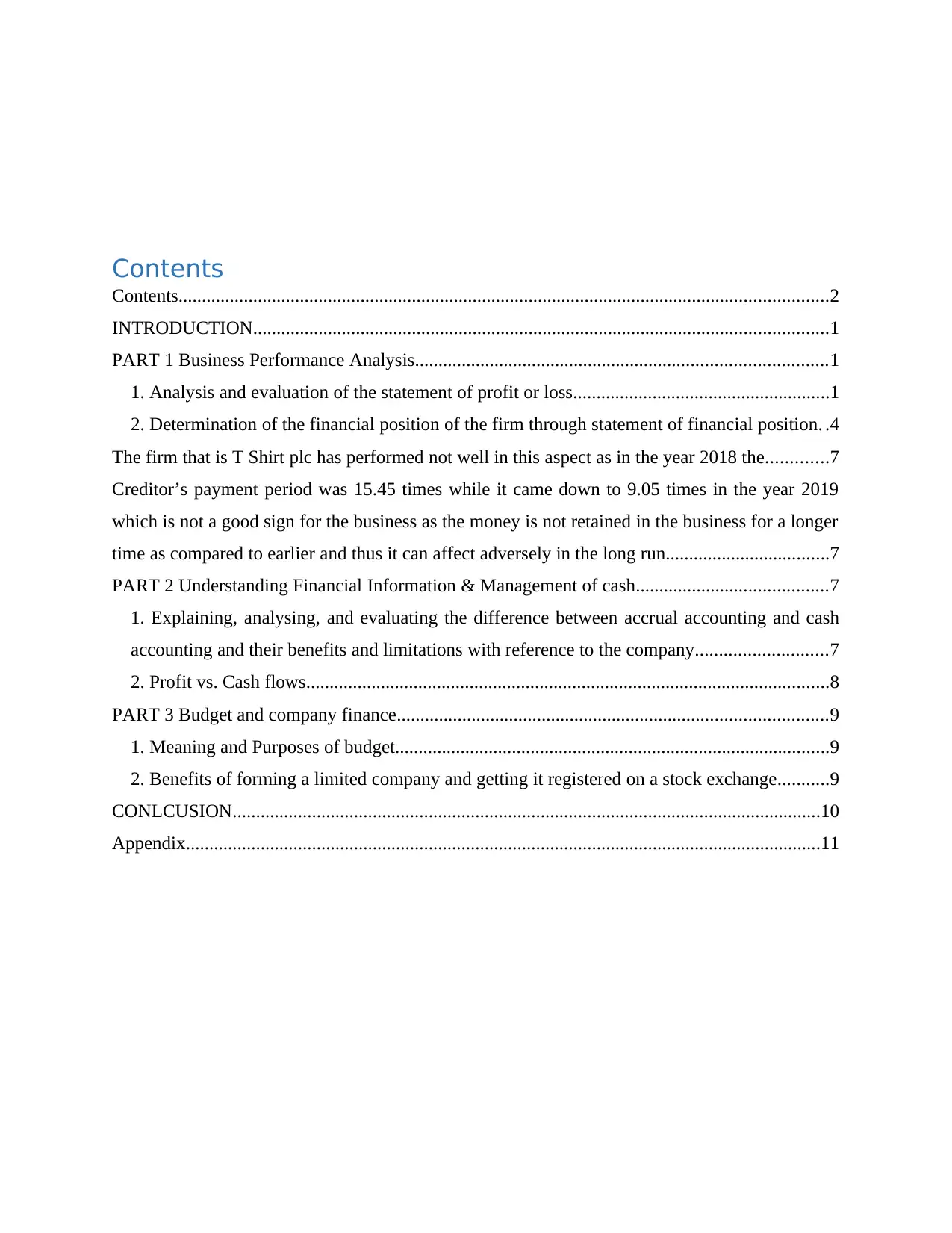
Contents
Contents...........................................................................................................................................2
INTRODUCTION...........................................................................................................................1
PART 1 Business Performance Analysis........................................................................................1
1. Analysis and evaluation of the statement of profit or loss.......................................................1
2. Determination of the financial position of the firm through statement of financial position. .4
The firm that is T Shirt plc has performed not well in this aspect as in the year 2018 the.............7
Creditor’s payment period was 15.45 times while it came down to 9.05 times in the year 2019
which is not a good sign for the business as the money is not retained in the business for a longer
time as compared to earlier and thus it can affect adversely in the long run...................................7
PART 2 Understanding Financial Information & Management of cash.........................................7
1. Explaining, analysing, and evaluating the difference between accrual accounting and cash
accounting and their benefits and limitations with reference to the company............................7
2. Profit vs. Cash flows................................................................................................................8
PART 3 Budget and company finance............................................................................................9
1. Meaning and Purposes of budget.............................................................................................9
2. Benefits of forming a limited company and getting it registered on a stock exchange...........9
CONLCUSION..............................................................................................................................10
Appendix........................................................................................................................................11
Contents...........................................................................................................................................2
INTRODUCTION...........................................................................................................................1
PART 1 Business Performance Analysis........................................................................................1
1. Analysis and evaluation of the statement of profit or loss.......................................................1
2. Determination of the financial position of the firm through statement of financial position. .4
The firm that is T Shirt plc has performed not well in this aspect as in the year 2018 the.............7
Creditor’s payment period was 15.45 times while it came down to 9.05 times in the year 2019
which is not a good sign for the business as the money is not retained in the business for a longer
time as compared to earlier and thus it can affect adversely in the long run...................................7
PART 2 Understanding Financial Information & Management of cash.........................................7
1. Explaining, analysing, and evaluating the difference between accrual accounting and cash
accounting and their benefits and limitations with reference to the company............................7
2. Profit vs. Cash flows................................................................................................................8
PART 3 Budget and company finance............................................................................................9
1. Meaning and Purposes of budget.............................................................................................9
2. Benefits of forming a limited company and getting it registered on a stock exchange...........9
CONLCUSION..............................................................................................................................10
Appendix........................................................................................................................................11
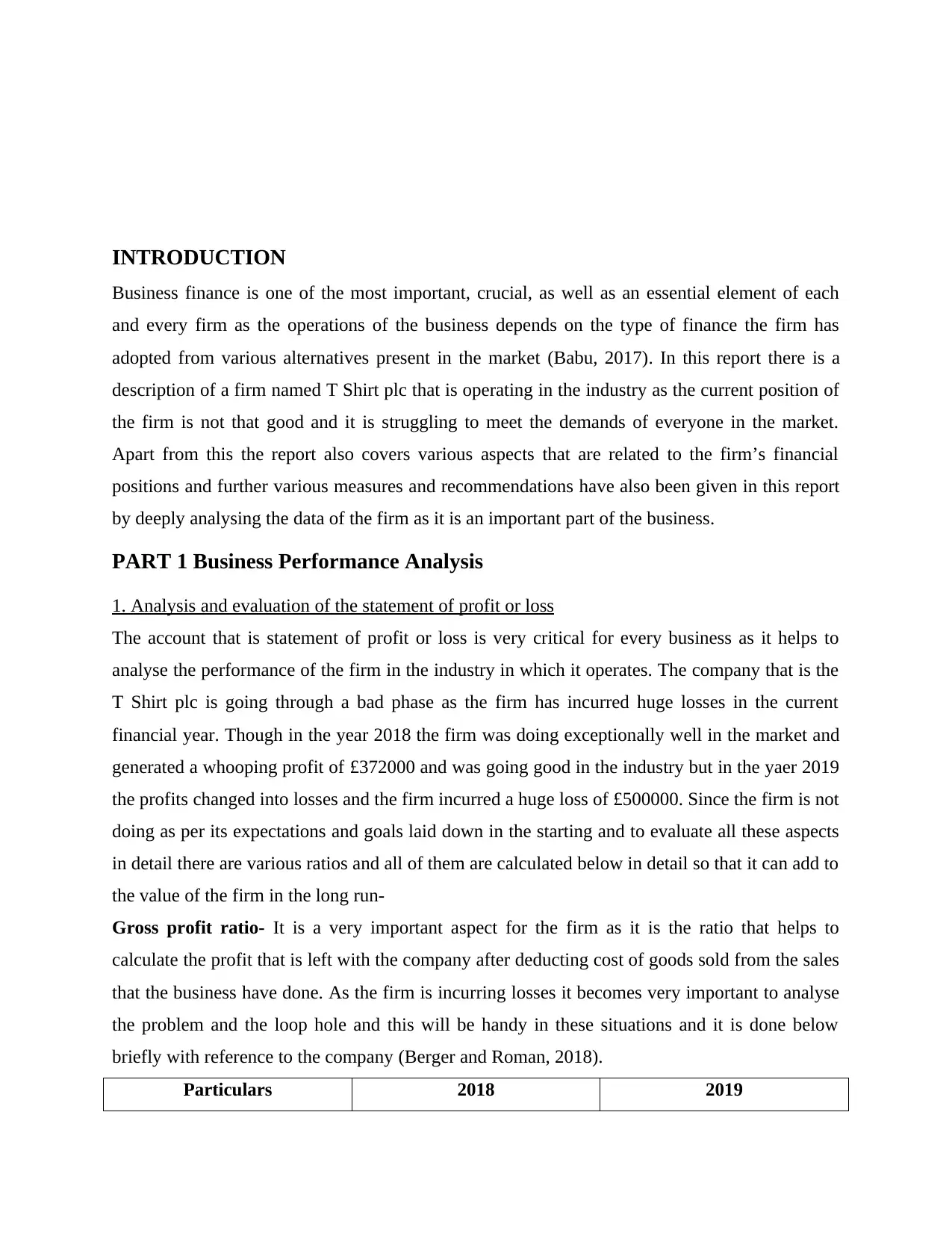
INTRODUCTION
Business finance is one of the most important, crucial, as well as an essential element of each
and every firm as the operations of the business depends on the type of finance the firm has
adopted from various alternatives present in the market (Babu, 2017). In this report there is a
description of a firm named T Shirt plc that is operating in the industry as the current position of
the firm is not that good and it is struggling to meet the demands of everyone in the market.
Apart from this the report also covers various aspects that are related to the firm’s financial
positions and further various measures and recommendations have also been given in this report
by deeply analysing the data of the firm as it is an important part of the business.
PART 1 Business Performance Analysis
1. Analysis and evaluation of the statement of profit or loss
The account that is statement of profit or loss is very critical for every business as it helps to
analyse the performance of the firm in the industry in which it operates. The company that is the
T Shirt plc is going through a bad phase as the firm has incurred huge losses in the current
financial year. Though in the year 2018 the firm was doing exceptionally well in the market and
generated a whooping profit of £372000 and was going good in the industry but in the yaer 2019
the profits changed into losses and the firm incurred a huge loss of £500000. Since the firm is not
doing as per its expectations and goals laid down in the starting and to evaluate all these aspects
in detail there are various ratios and all of them are calculated below in detail so that it can add to
the value of the firm in the long run-
Gross profit ratio- It is a very important aspect for the firm as it is the ratio that helps to
calculate the profit that is left with the company after deducting cost of goods sold from the sales
that the business have done. As the firm is incurring losses it becomes very important to analyse
the problem and the loop hole and this will be handy in these situations and it is done below
briefly with reference to the company (Berger and Roman, 2018).
Particulars 2018 2019
Business finance is one of the most important, crucial, as well as an essential element of each
and every firm as the operations of the business depends on the type of finance the firm has
adopted from various alternatives present in the market (Babu, 2017). In this report there is a
description of a firm named T Shirt plc that is operating in the industry as the current position of
the firm is not that good and it is struggling to meet the demands of everyone in the market.
Apart from this the report also covers various aspects that are related to the firm’s financial
positions and further various measures and recommendations have also been given in this report
by deeply analysing the data of the firm as it is an important part of the business.
PART 1 Business Performance Analysis
1. Analysis and evaluation of the statement of profit or loss
The account that is statement of profit or loss is very critical for every business as it helps to
analyse the performance of the firm in the industry in which it operates. The company that is the
T Shirt plc is going through a bad phase as the firm has incurred huge losses in the current
financial year. Though in the year 2018 the firm was doing exceptionally well in the market and
generated a whooping profit of £372000 and was going good in the industry but in the yaer 2019
the profits changed into losses and the firm incurred a huge loss of £500000. Since the firm is not
doing as per its expectations and goals laid down in the starting and to evaluate all these aspects
in detail there are various ratios and all of them are calculated below in detail so that it can add to
the value of the firm in the long run-
Gross profit ratio- It is a very important aspect for the firm as it is the ratio that helps to
calculate the profit that is left with the company after deducting cost of goods sold from the sales
that the business have done. As the firm is incurring losses it becomes very important to analyse
the problem and the loop hole and this will be handy in these situations and it is done below
briefly with reference to the company (Berger and Roman, 2018).
Particulars 2018 2019
⊘ This is a preview!⊘
Do you want full access?
Subscribe today to unlock all pages.

Trusted by 1+ million students worldwide
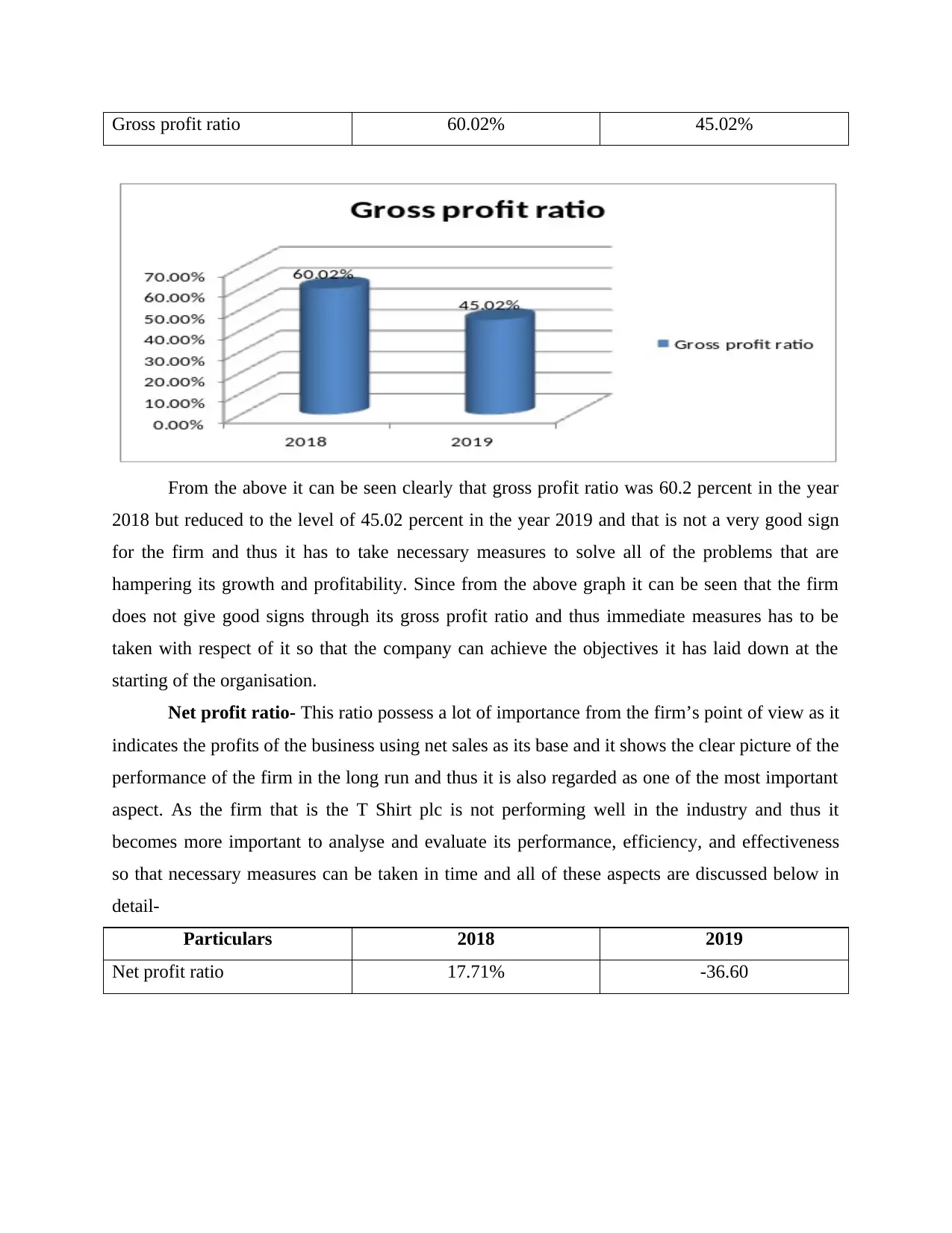
Gross profit ratio 60.02% 45.02%
From the above it can be seen clearly that gross profit ratio was 60.2 percent in the year
2018 but reduced to the level of 45.02 percent in the year 2019 and that is not a very good sign
for the firm and thus it has to take necessary measures to solve all of the problems that are
hampering its growth and profitability. Since from the above graph it can be seen that the firm
does not give good signs through its gross profit ratio and thus immediate measures has to be
taken with respect of it so that the company can achieve the objectives it has laid down at the
starting of the organisation.
Net profit ratio- This ratio possess a lot of importance from the firm’s point of view as it
indicates the profits of the business using net sales as its base and it shows the clear picture of the
performance of the firm in the long run and thus it is also regarded as one of the most important
aspect. As the firm that is the T Shirt plc is not performing well in the industry and thus it
becomes more important to analyse and evaluate its performance, efficiency, and effectiveness
so that necessary measures can be taken in time and all of these aspects are discussed below in
detail-
Particulars 2018 2019
Net profit ratio 17.71% -36.60
From the above it can be seen clearly that gross profit ratio was 60.2 percent in the year
2018 but reduced to the level of 45.02 percent in the year 2019 and that is not a very good sign
for the firm and thus it has to take necessary measures to solve all of the problems that are
hampering its growth and profitability. Since from the above graph it can be seen that the firm
does not give good signs through its gross profit ratio and thus immediate measures has to be
taken with respect of it so that the company can achieve the objectives it has laid down at the
starting of the organisation.
Net profit ratio- This ratio possess a lot of importance from the firm’s point of view as it
indicates the profits of the business using net sales as its base and it shows the clear picture of the
performance of the firm in the long run and thus it is also regarded as one of the most important
aspect. As the firm that is the T Shirt plc is not performing well in the industry and thus it
becomes more important to analyse and evaluate its performance, efficiency, and effectiveness
so that necessary measures can be taken in time and all of these aspects are discussed below in
detail-
Particulars 2018 2019
Net profit ratio 17.71% -36.60
Paraphrase This Document
Need a fresh take? Get an instant paraphrase of this document with our AI Paraphraser
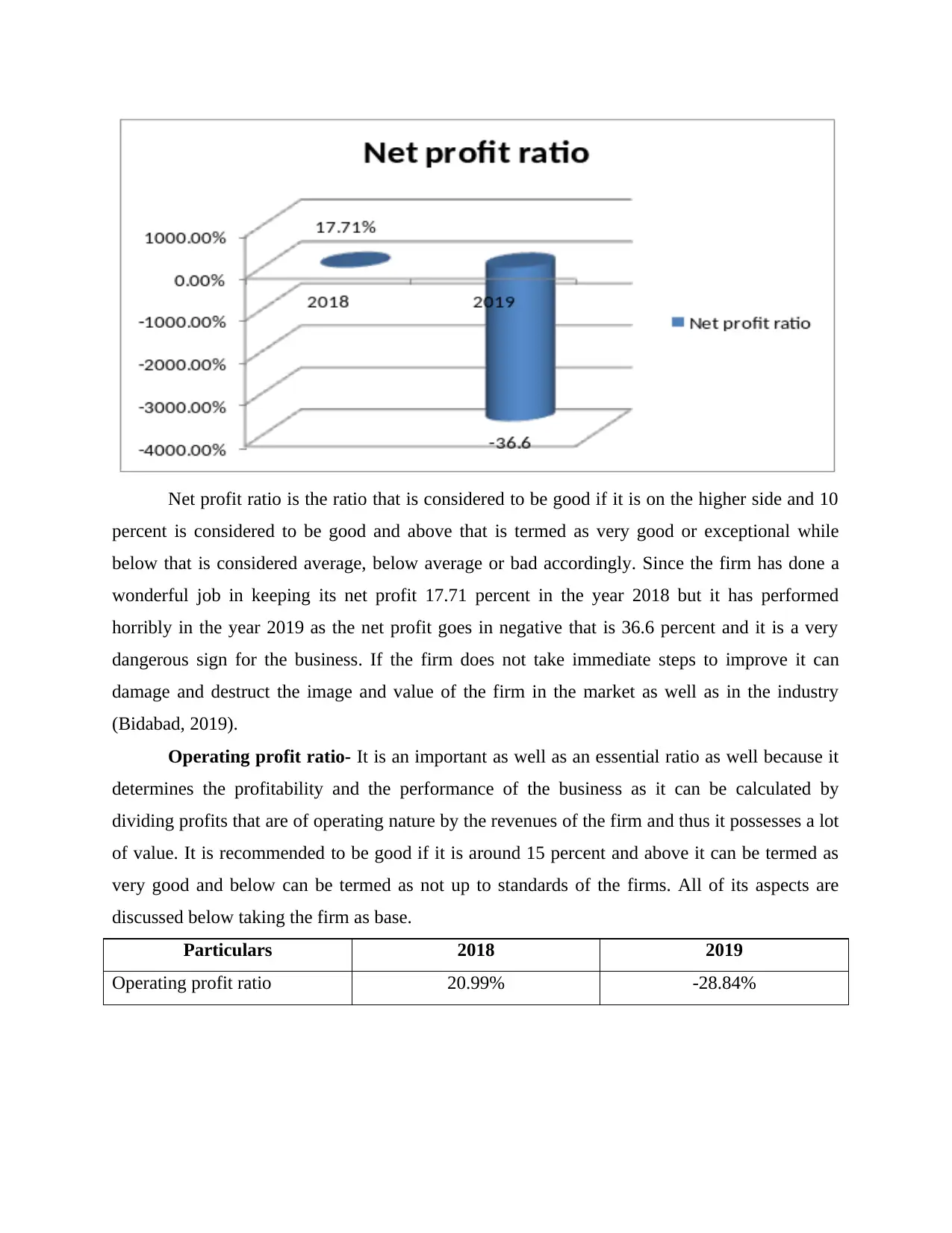
Net profit ratio is the ratio that is considered to be good if it is on the higher side and 10
percent is considered to be good and above that is termed as very good or exceptional while
below that is considered average, below average or bad accordingly. Since the firm has done a
wonderful job in keeping its net profit 17.71 percent in the year 2018 but it has performed
horribly in the year 2019 as the net profit goes in negative that is 36.6 percent and it is a very
dangerous sign for the business. If the firm does not take immediate steps to improve it can
damage and destruct the image and value of the firm in the market as well as in the industry
(Bidabad, 2019).
Operating profit ratio- It is an important as well as an essential ratio as well because it
determines the profitability and the performance of the business as it can be calculated by
dividing profits that are of operating nature by the revenues of the firm and thus it possesses a lot
of value. It is recommended to be good if it is around 15 percent and above it can be termed as
very good and below can be termed as not up to standards of the firms. All of its aspects are
discussed below taking the firm as base.
Particulars 2018 2019
Operating profit ratio 20.99% -28.84%
percent is considered to be good and above that is termed as very good or exceptional while
below that is considered average, below average or bad accordingly. Since the firm has done a
wonderful job in keeping its net profit 17.71 percent in the year 2018 but it has performed
horribly in the year 2019 as the net profit goes in negative that is 36.6 percent and it is a very
dangerous sign for the business. If the firm does not take immediate steps to improve it can
damage and destruct the image and value of the firm in the market as well as in the industry
(Bidabad, 2019).
Operating profit ratio- It is an important as well as an essential ratio as well because it
determines the profitability and the performance of the business as it can be calculated by
dividing profits that are of operating nature by the revenues of the firm and thus it possesses a lot
of value. It is recommended to be good if it is around 15 percent and above it can be termed as
very good and below can be termed as not up to standards of the firms. All of its aspects are
discussed below taking the firm as base.
Particulars 2018 2019
Operating profit ratio 20.99% -28.84%
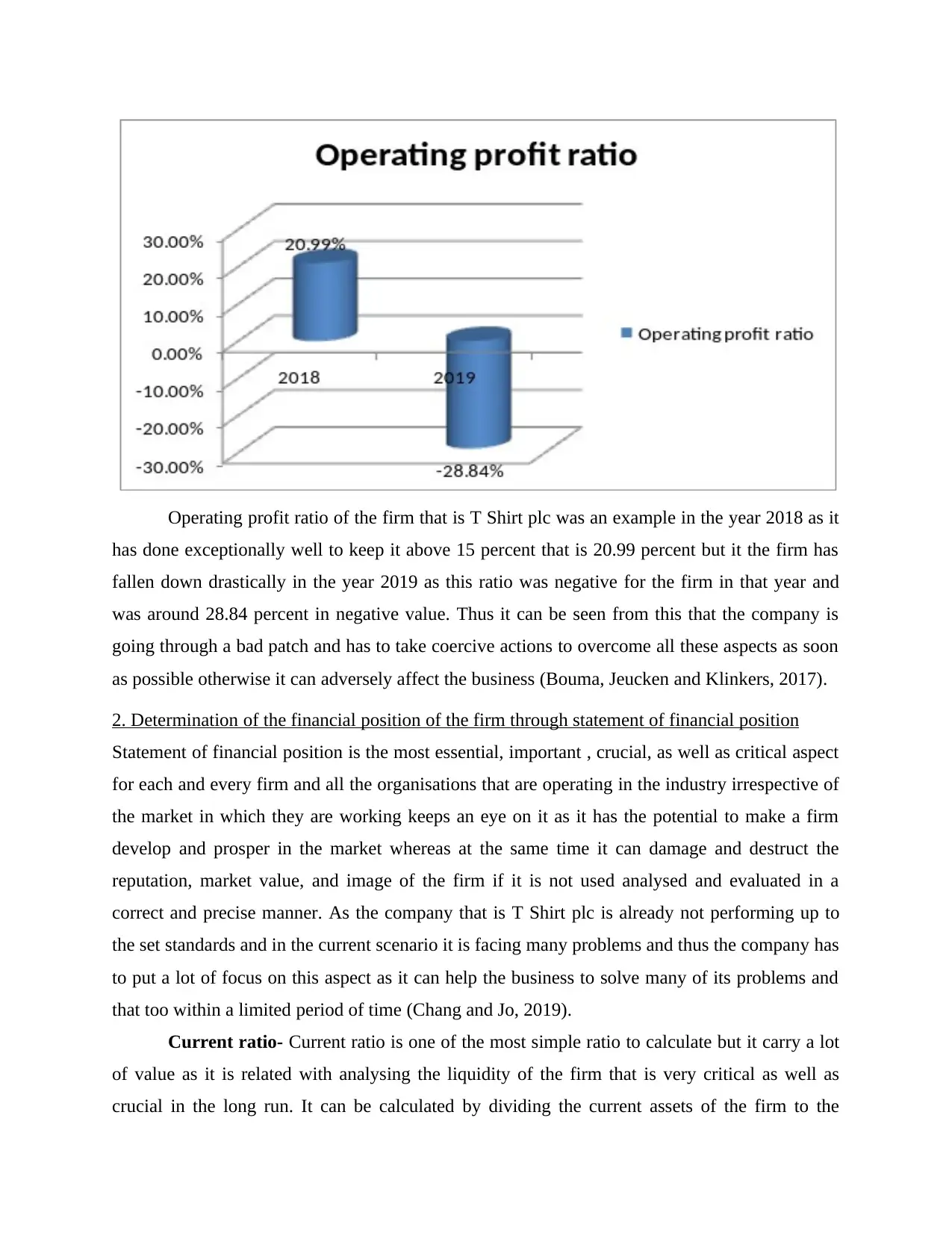
Operating profit ratio of the firm that is T Shirt plc was an example in the year 2018 as it
has done exceptionally well to keep it above 15 percent that is 20.99 percent but it the firm has
fallen down drastically in the year 2019 as this ratio was negative for the firm in that year and
was around 28.84 percent in negative value. Thus it can be seen from this that the company is
going through a bad patch and has to take coercive actions to overcome all these aspects as soon
as possible otherwise it can adversely affect the business (Bouma, Jeucken and Klinkers, 2017).
2. Determination of the financial position of the firm through statement of financial position
Statement of financial position is the most essential, important , crucial, as well as critical aspect
for each and every firm and all the organisations that are operating in the industry irrespective of
the market in which they are working keeps an eye on it as it has the potential to make a firm
develop and prosper in the market whereas at the same time it can damage and destruct the
reputation, market value, and image of the firm if it is not used analysed and evaluated in a
correct and precise manner. As the company that is T Shirt plc is already not performing up to
the set standards and in the current scenario it is facing many problems and thus the company has
to put a lot of focus on this aspect as it can help the business to solve many of its problems and
that too within a limited period of time (Chang and Jo, 2019).
Current ratio- Current ratio is one of the most simple ratio to calculate but it carry a lot
of value as it is related with analysing the liquidity of the firm that is very critical as well as
crucial in the long run. It can be calculated by dividing the current assets of the firm to the
has done exceptionally well to keep it above 15 percent that is 20.99 percent but it the firm has
fallen down drastically in the year 2019 as this ratio was negative for the firm in that year and
was around 28.84 percent in negative value. Thus it can be seen from this that the company is
going through a bad patch and has to take coercive actions to overcome all these aspects as soon
as possible otherwise it can adversely affect the business (Bouma, Jeucken and Klinkers, 2017).
2. Determination of the financial position of the firm through statement of financial position
Statement of financial position is the most essential, important , crucial, as well as critical aspect
for each and every firm and all the organisations that are operating in the industry irrespective of
the market in which they are working keeps an eye on it as it has the potential to make a firm
develop and prosper in the market whereas at the same time it can damage and destruct the
reputation, market value, and image of the firm if it is not used analysed and evaluated in a
correct and precise manner. As the company that is T Shirt plc is already not performing up to
the set standards and in the current scenario it is facing many problems and thus the company has
to put a lot of focus on this aspect as it can help the business to solve many of its problems and
that too within a limited period of time (Chang and Jo, 2019).
Current ratio- Current ratio is one of the most simple ratio to calculate but it carry a lot
of value as it is related with analysing the liquidity of the firm that is very critical as well as
crucial in the long run. It can be calculated by dividing the current assets of the firm to the
⊘ This is a preview!⊘
Do you want full access?
Subscribe today to unlock all pages.

Trusted by 1+ million students worldwide
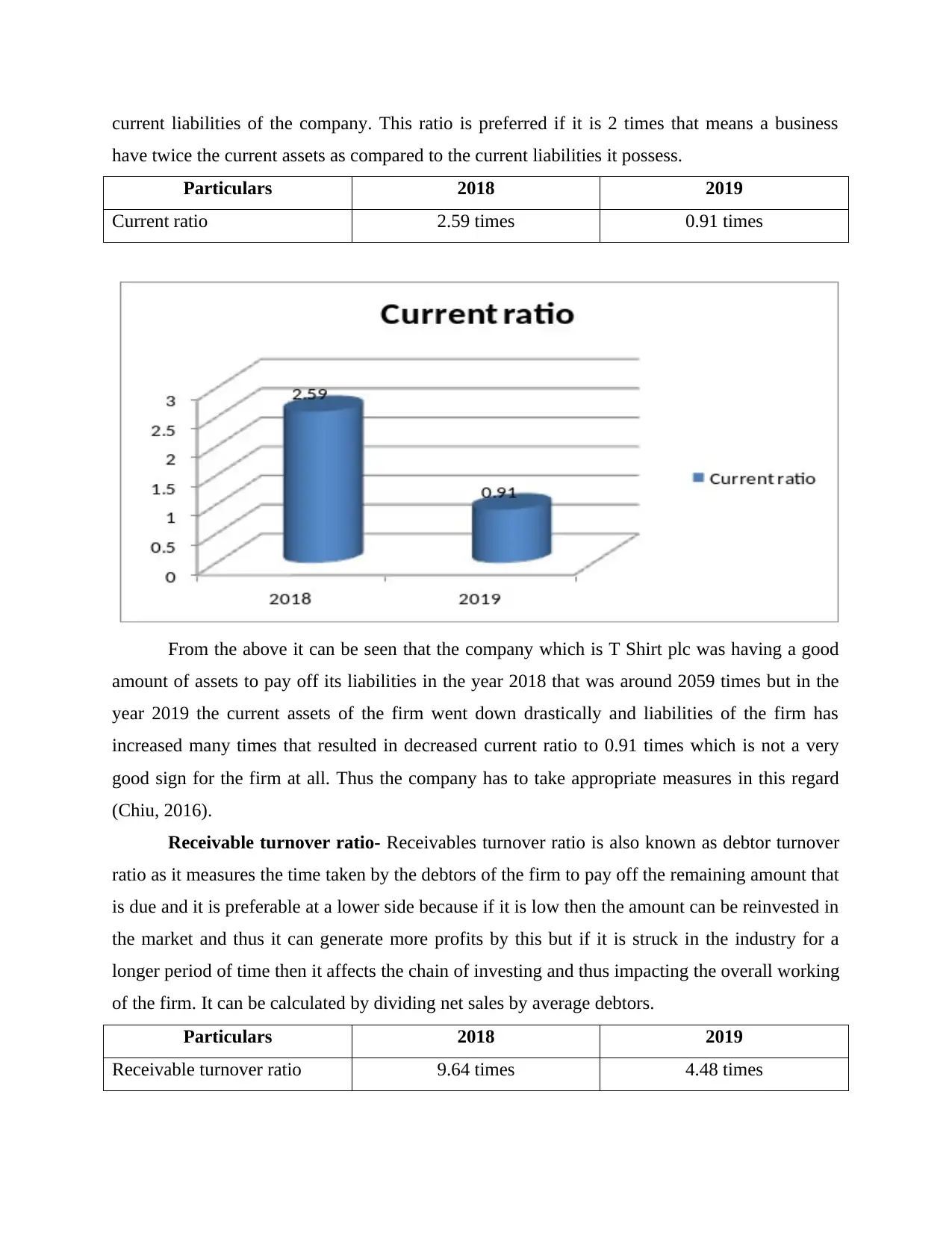
current liabilities of the company. This ratio is preferred if it is 2 times that means a business
have twice the current assets as compared to the current liabilities it possess.
Particulars 2018 2019
Current ratio 2.59 times 0.91 times
From the above it can be seen that the company which is T Shirt plc was having a good
amount of assets to pay off its liabilities in the year 2018 that was around 2059 times but in the
year 2019 the current assets of the firm went down drastically and liabilities of the firm has
increased many times that resulted in decreased current ratio to 0.91 times which is not a very
good sign for the firm at all. Thus the company has to take appropriate measures in this regard
(Chiu, 2016).
Receivable turnover ratio- Receivables turnover ratio is also known as debtor turnover
ratio as it measures the time taken by the debtors of the firm to pay off the remaining amount that
is due and it is preferable at a lower side because if it is low then the amount can be reinvested in
the market and thus it can generate more profits by this but if it is struck in the industry for a
longer period of time then it affects the chain of investing and thus impacting the overall working
of the firm. It can be calculated by dividing net sales by average debtors.
Particulars 2018 2019
Receivable turnover ratio 9.64 times 4.48 times
have twice the current assets as compared to the current liabilities it possess.
Particulars 2018 2019
Current ratio 2.59 times 0.91 times
From the above it can be seen that the company which is T Shirt plc was having a good
amount of assets to pay off its liabilities in the year 2018 that was around 2059 times but in the
year 2019 the current assets of the firm went down drastically and liabilities of the firm has
increased many times that resulted in decreased current ratio to 0.91 times which is not a very
good sign for the firm at all. Thus the company has to take appropriate measures in this regard
(Chiu, 2016).
Receivable turnover ratio- Receivables turnover ratio is also known as debtor turnover
ratio as it measures the time taken by the debtors of the firm to pay off the remaining amount that
is due and it is preferable at a lower side because if it is low then the amount can be reinvested in
the market and thus it can generate more profits by this but if it is struck in the industry for a
longer period of time then it affects the chain of investing and thus impacting the overall working
of the firm. It can be calculated by dividing net sales by average debtors.
Particulars 2018 2019
Receivable turnover ratio 9.64 times 4.48 times
Paraphrase This Document
Need a fresh take? Get an instant paraphrase of this document with our AI Paraphraser
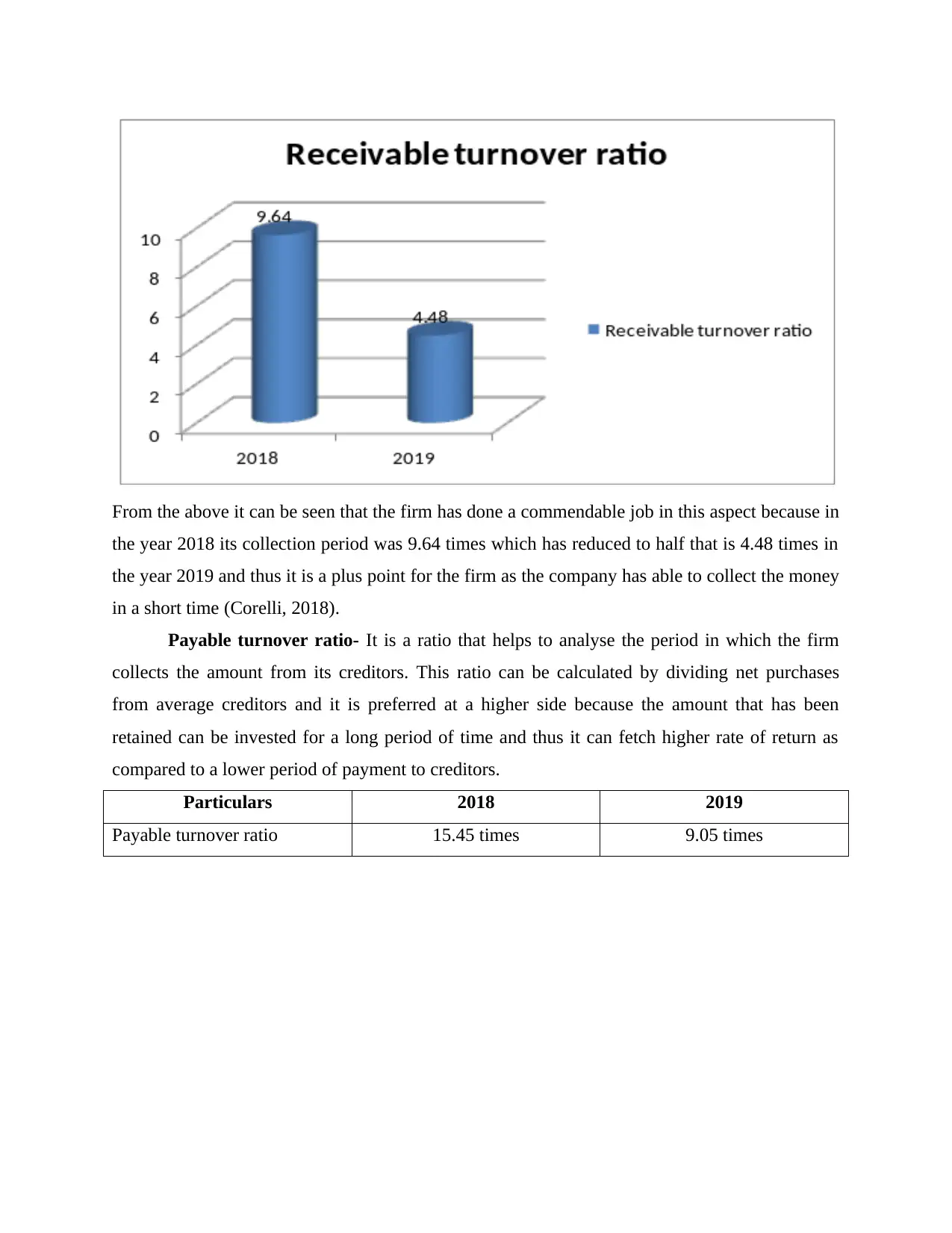
From the above it can be seen that the firm has done a commendable job in this aspect because in
the year 2018 its collection period was 9.64 times which has reduced to half that is 4.48 times in
the year 2019 and thus it is a plus point for the firm as the company has able to collect the money
in a short time (Corelli, 2018).
Payable turnover ratio- It is a ratio that helps to analyse the period in which the firm
collects the amount from its creditors. This ratio can be calculated by dividing net purchases
from average creditors and it is preferred at a higher side because the amount that has been
retained can be invested for a long period of time and thus it can fetch higher rate of return as
compared to a lower period of payment to creditors.
Particulars 2018 2019
Payable turnover ratio 15.45 times 9.05 times
the year 2018 its collection period was 9.64 times which has reduced to half that is 4.48 times in
the year 2019 and thus it is a plus point for the firm as the company has able to collect the money
in a short time (Corelli, 2018).
Payable turnover ratio- It is a ratio that helps to analyse the period in which the firm
collects the amount from its creditors. This ratio can be calculated by dividing net purchases
from average creditors and it is preferred at a higher side because the amount that has been
retained can be invested for a long period of time and thus it can fetch higher rate of return as
compared to a lower period of payment to creditors.
Particulars 2018 2019
Payable turnover ratio 15.45 times 9.05 times
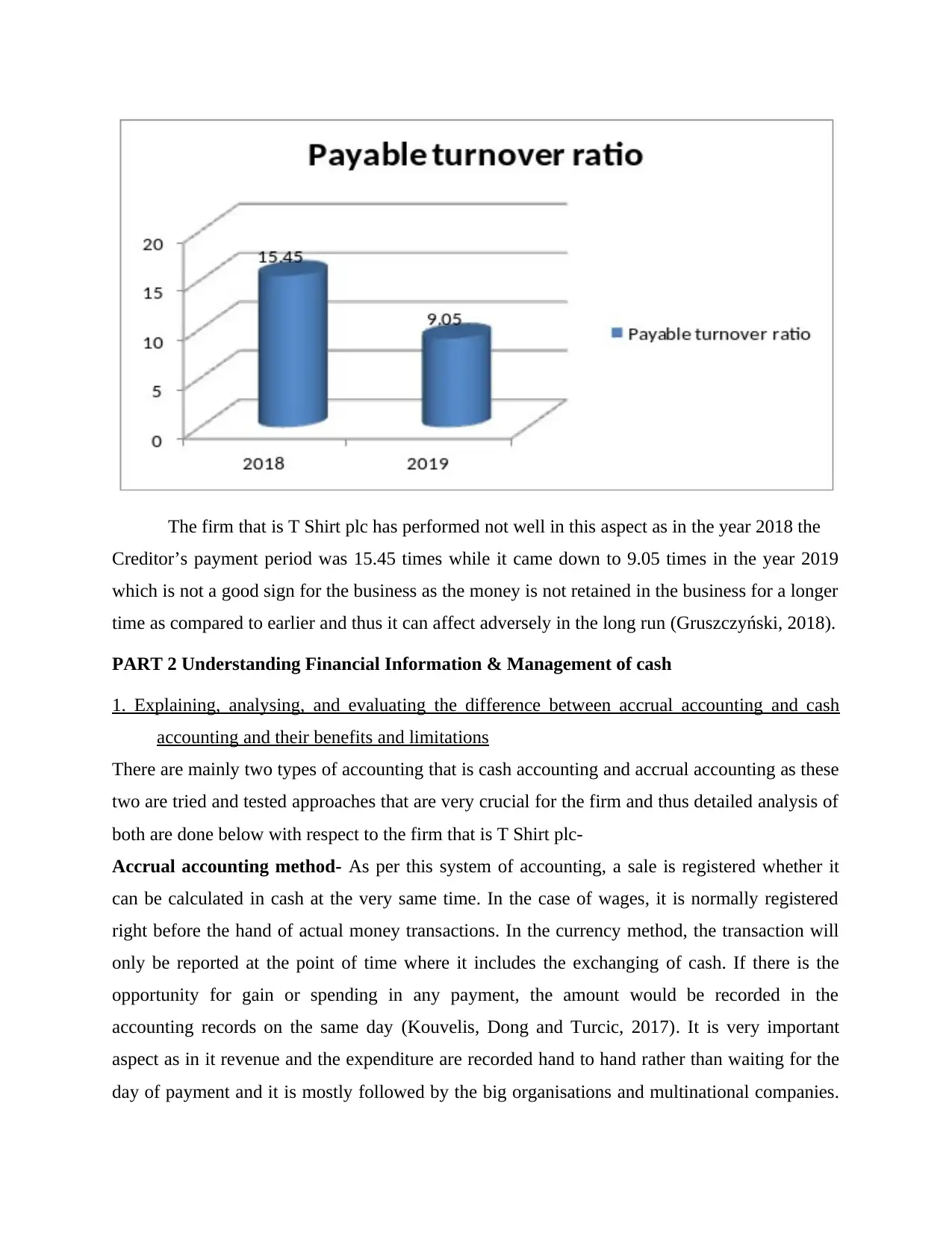
The firm that is T Shirt plc has performed not well in this aspect as in the year 2018 the
Creditor’s payment period was 15.45 times while it came down to 9.05 times in the year 2019
which is not a good sign for the business as the money is not retained in the business for a longer
time as compared to earlier and thus it can affect adversely in the long run (Gruszczyński, 2018).
PART 2 Understanding Financial Information & Management of cash
1. Explaining, analysing, and evaluating the difference between accrual accounting and cash
accounting and their benefits and limitations
There are mainly two types of accounting that is cash accounting and accrual accounting as these
two are tried and tested approaches that are very crucial for the firm and thus detailed analysis of
both are done below with respect to the firm that is T Shirt plc-
Accrual accounting method- As per this system of accounting, a sale is registered whether it
can be calculated in cash at the very same time. In the case of wages, it is normally registered
right before the hand of actual money transactions. In the currency method, the transaction will
only be reported at the point of time where it includes the exchanging of cash. If there is the
opportunity for gain or spending in any payment, the amount would be recorded in the
accounting records on the same day (Kouvelis, Dong and Turcic, 2017). It is very important
aspect as in it revenue and the expenditure are recorded hand to hand rather than waiting for the
day of payment and it is mostly followed by the big organisations and multinational companies.
Creditor’s payment period was 15.45 times while it came down to 9.05 times in the year 2019
which is not a good sign for the business as the money is not retained in the business for a longer
time as compared to earlier and thus it can affect adversely in the long run (Gruszczyński, 2018).
PART 2 Understanding Financial Information & Management of cash
1. Explaining, analysing, and evaluating the difference between accrual accounting and cash
accounting and their benefits and limitations
There are mainly two types of accounting that is cash accounting and accrual accounting as these
two are tried and tested approaches that are very crucial for the firm and thus detailed analysis of
both are done below with respect to the firm that is T Shirt plc-
Accrual accounting method- As per this system of accounting, a sale is registered whether it
can be calculated in cash at the very same time. In the case of wages, it is normally registered
right before the hand of actual money transactions. In the currency method, the transaction will
only be reported at the point of time where it includes the exchanging of cash. If there is the
opportunity for gain or spending in any payment, the amount would be recorded in the
accounting records on the same day (Kouvelis, Dong and Turcic, 2017). It is very important
aspect as in it revenue and the expenditure are recorded hand to hand rather than waiting for the
day of payment and it is mostly followed by the big organisations and multinational companies.
⊘ This is a preview!⊘
Do you want full access?
Subscribe today to unlock all pages.

Trusted by 1+ million students worldwide
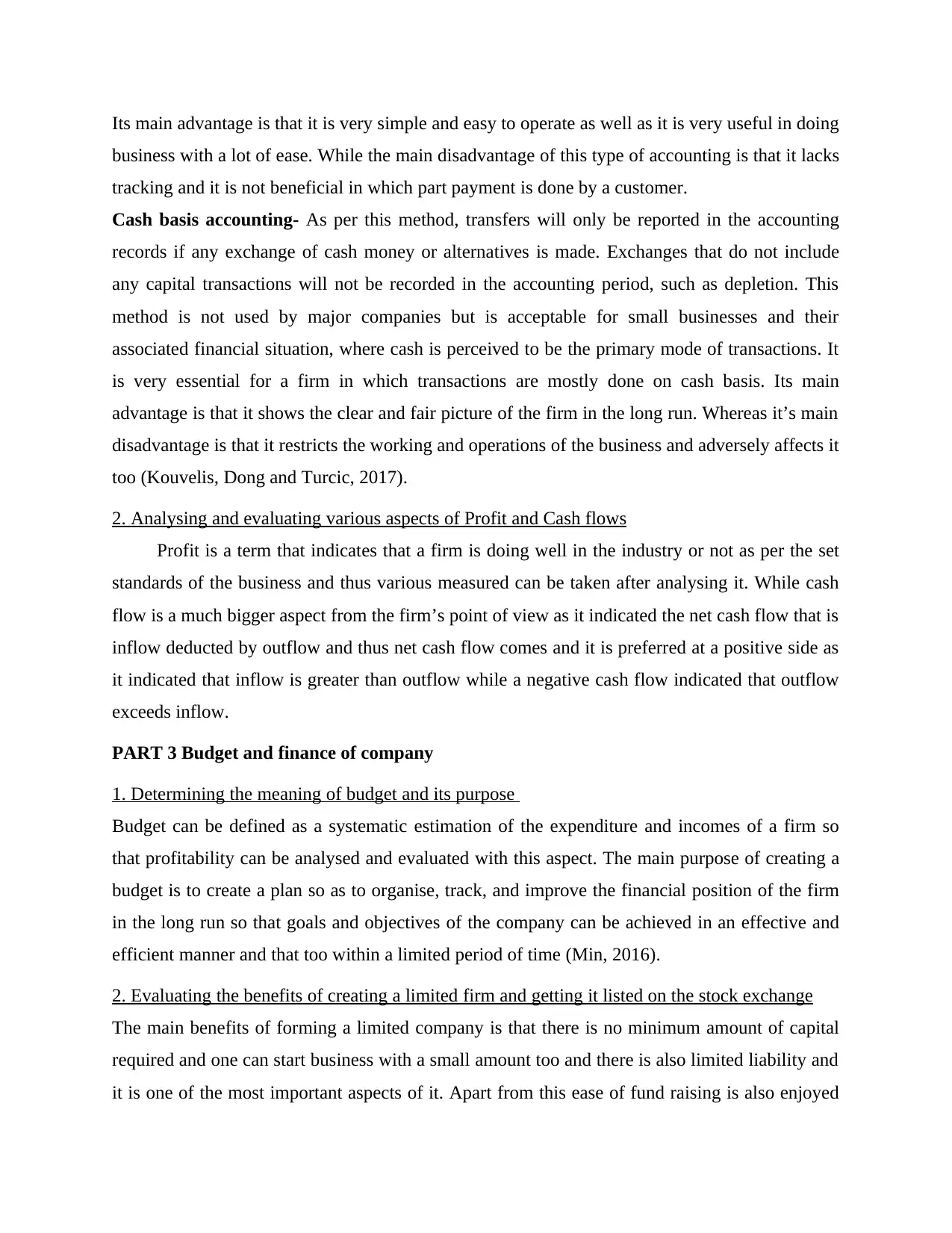
Its main advantage is that it is very simple and easy to operate as well as it is very useful in doing
business with a lot of ease. While the main disadvantage of this type of accounting is that it lacks
tracking and it is not beneficial in which part payment is done by a customer.
Cash basis accounting- As per this method, transfers will only be reported in the accounting
records if any exchange of cash money or alternatives is made. Exchanges that do not include
any capital transactions will not be recorded in the accounting period, such as depletion. This
method is not used by major companies but is acceptable for small businesses and their
associated financial situation, where cash is perceived to be the primary mode of transactions. It
is very essential for a firm in which transactions are mostly done on cash basis. Its main
advantage is that it shows the clear and fair picture of the firm in the long run. Whereas it’s main
disadvantage is that it restricts the working and operations of the business and adversely affects it
too (Kouvelis, Dong and Turcic, 2017).
2. Analysing and evaluating various aspects of Profit and Cash flows
Profit is a term that indicates that a firm is doing well in the industry or not as per the set
standards of the business and thus various measured can be taken after analysing it. While cash
flow is a much bigger aspect from the firm’s point of view as it indicated the net cash flow that is
inflow deducted by outflow and thus net cash flow comes and it is preferred at a positive side as
it indicated that inflow is greater than outflow while a negative cash flow indicated that outflow
exceeds inflow.
PART 3 Budget and finance of company
1. Determining the meaning of budget and its purpose
Budget can be defined as a systematic estimation of the expenditure and incomes of a firm so
that profitability can be analysed and evaluated with this aspect. The main purpose of creating a
budget is to create a plan so as to organise, track, and improve the financial position of the firm
in the long run so that goals and objectives of the company can be achieved in an effective and
efficient manner and that too within a limited period of time (Min, 2016).
2. Evaluating the benefits of creating a limited firm and getting it listed on the stock exchange
The main benefits of forming a limited company is that there is no minimum amount of capital
required and one can start business with a small amount too and there is also limited liability and
it is one of the most important aspects of it. Apart from this ease of fund raising is also enjoyed
business with a lot of ease. While the main disadvantage of this type of accounting is that it lacks
tracking and it is not beneficial in which part payment is done by a customer.
Cash basis accounting- As per this method, transfers will only be reported in the accounting
records if any exchange of cash money or alternatives is made. Exchanges that do not include
any capital transactions will not be recorded in the accounting period, such as depletion. This
method is not used by major companies but is acceptable for small businesses and their
associated financial situation, where cash is perceived to be the primary mode of transactions. It
is very essential for a firm in which transactions are mostly done on cash basis. Its main
advantage is that it shows the clear and fair picture of the firm in the long run. Whereas it’s main
disadvantage is that it restricts the working and operations of the business and adversely affects it
too (Kouvelis, Dong and Turcic, 2017).
2. Analysing and evaluating various aspects of Profit and Cash flows
Profit is a term that indicates that a firm is doing well in the industry or not as per the set
standards of the business and thus various measured can be taken after analysing it. While cash
flow is a much bigger aspect from the firm’s point of view as it indicated the net cash flow that is
inflow deducted by outflow and thus net cash flow comes and it is preferred at a positive side as
it indicated that inflow is greater than outflow while a negative cash flow indicated that outflow
exceeds inflow.
PART 3 Budget and finance of company
1. Determining the meaning of budget and its purpose
Budget can be defined as a systematic estimation of the expenditure and incomes of a firm so
that profitability can be analysed and evaluated with this aspect. The main purpose of creating a
budget is to create a plan so as to organise, track, and improve the financial position of the firm
in the long run so that goals and objectives of the company can be achieved in an effective and
efficient manner and that too within a limited period of time (Min, 2016).
2. Evaluating the benefits of creating a limited firm and getting it listed on the stock exchange
The main benefits of forming a limited company is that there is no minimum amount of capital
required and one can start business with a small amount too and there is also limited liability and
it is one of the most important aspects of it. Apart from this ease of fund raising is also enjoyed
Paraphrase This Document
Need a fresh take? Get an instant paraphrase of this document with our AI Paraphraser
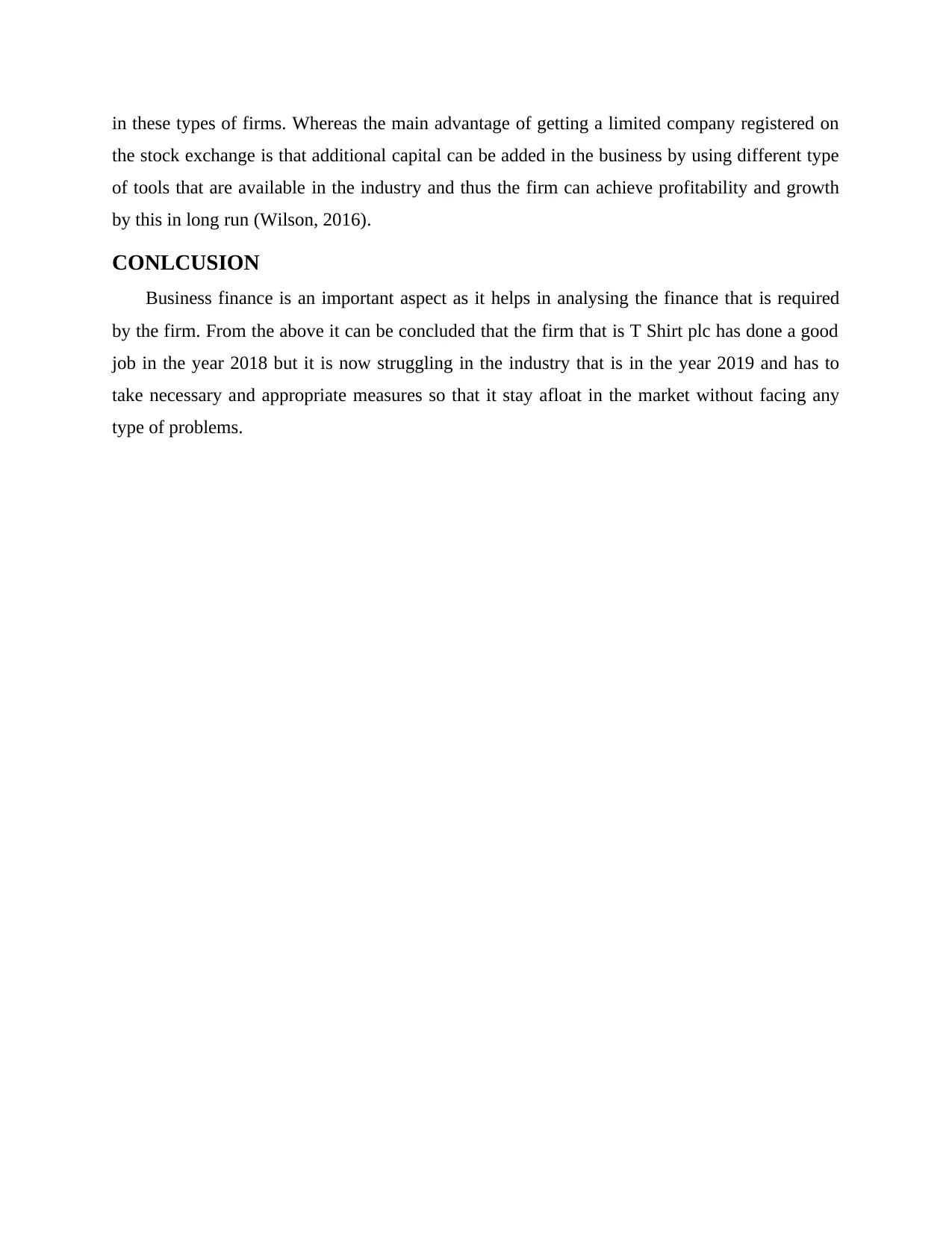
in these types of firms. Whereas the main advantage of getting a limited company registered on
the stock exchange is that additional capital can be added in the business by using different type
of tools that are available in the industry and thus the firm can achieve profitability and growth
by this in long run (Wilson, 2016).
CONLCUSION
Business finance is an important aspect as it helps in analysing the finance that is required
by the firm. From the above it can be concluded that the firm that is T Shirt plc has done a good
job in the year 2018 but it is now struggling in the industry that is in the year 2019 and has to
take necessary and appropriate measures so that it stay afloat in the market without facing any
type of problems.
the stock exchange is that additional capital can be added in the business by using different type
of tools that are available in the industry and thus the firm can achieve profitability and growth
by this in long run (Wilson, 2016).
CONLCUSION
Business finance is an important aspect as it helps in analysing the finance that is required
by the firm. From the above it can be concluded that the firm that is T Shirt plc has done a good
job in the year 2018 but it is now struggling in the industry that is in the year 2019 and has to
take necessary and appropriate measures so that it stay afloat in the market without facing any
type of problems.
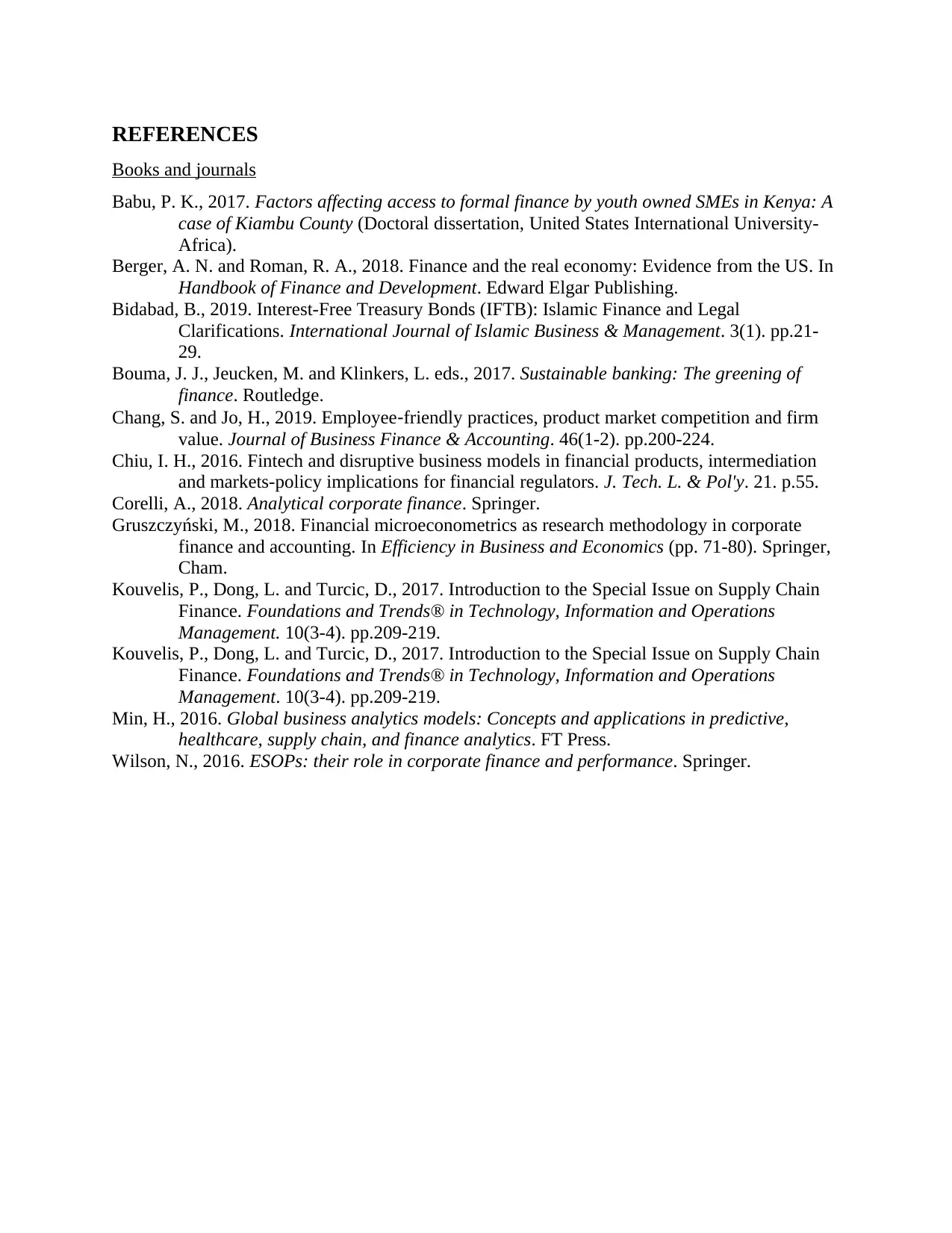
REFERENCES
Books and journals
Babu, P. K., 2017. Factors affecting access to formal finance by youth owned SMEs in Kenya: A
case of Kiambu County (Doctoral dissertation, United States International University-
Africa).
Berger, A. N. and Roman, R. A., 2018. Finance and the real economy: Evidence from the US. In
Handbook of Finance and Development. Edward Elgar Publishing.
Bidabad, B., 2019. Interest-Free Treasury Bonds (IFTB): Islamic Finance and Legal
Clarifications. International Journal of Islamic Business & Management. 3(1). pp.21-
29.
Bouma, J. J., Jeucken, M. and Klinkers, L. eds., 2017. Sustainable banking: The greening of
finance. Routledge.
Chang, S. and Jo, H., 2019. Employee‐friendly practices, product market competition and firm
value. Journal of Business Finance & Accounting. 46(1-2). pp.200-224.
Chiu, I. H., 2016. Fintech and disruptive business models in financial products, intermediation
and markets-policy implications for financial regulators. J. Tech. L. & Pol'y. 21. p.55.
Corelli, A., 2018. Analytical corporate finance. Springer.
Gruszczyński, M., 2018. Financial microeconometrics as research methodology in corporate
finance and accounting. In Efficiency in Business and Economics (pp. 71-80). Springer,
Cham.
Kouvelis, P., Dong, L. and Turcic, D., 2017. Introduction to the Special Issue on Supply Chain
Finance. Foundations and Trends® in Technology, Information and Operations
Management. 10(3-4). pp.209-219.
Kouvelis, P., Dong, L. and Turcic, D., 2017. Introduction to the Special Issue on Supply Chain
Finance. Foundations and Trends® in Technology, Information and Operations
Management. 10(3-4). pp.209-219.
Min, H., 2016. Global business analytics models: Concepts and applications in predictive,
healthcare, supply chain, and finance analytics. FT Press.
Wilson, N., 2016. ESOPs: their role in corporate finance and performance. Springer.
Books and journals
Babu, P. K., 2017. Factors affecting access to formal finance by youth owned SMEs in Kenya: A
case of Kiambu County (Doctoral dissertation, United States International University-
Africa).
Berger, A. N. and Roman, R. A., 2018. Finance and the real economy: Evidence from the US. In
Handbook of Finance and Development. Edward Elgar Publishing.
Bidabad, B., 2019. Interest-Free Treasury Bonds (IFTB): Islamic Finance and Legal
Clarifications. International Journal of Islamic Business & Management. 3(1). pp.21-
29.
Bouma, J. J., Jeucken, M. and Klinkers, L. eds., 2017. Sustainable banking: The greening of
finance. Routledge.
Chang, S. and Jo, H., 2019. Employee‐friendly practices, product market competition and firm
value. Journal of Business Finance & Accounting. 46(1-2). pp.200-224.
Chiu, I. H., 2016. Fintech and disruptive business models in financial products, intermediation
and markets-policy implications for financial regulators. J. Tech. L. & Pol'y. 21. p.55.
Corelli, A., 2018. Analytical corporate finance. Springer.
Gruszczyński, M., 2018. Financial microeconometrics as research methodology in corporate
finance and accounting. In Efficiency in Business and Economics (pp. 71-80). Springer,
Cham.
Kouvelis, P., Dong, L. and Turcic, D., 2017. Introduction to the Special Issue on Supply Chain
Finance. Foundations and Trends® in Technology, Information and Operations
Management. 10(3-4). pp.209-219.
Kouvelis, P., Dong, L. and Turcic, D., 2017. Introduction to the Special Issue on Supply Chain
Finance. Foundations and Trends® in Technology, Information and Operations
Management. 10(3-4). pp.209-219.
Min, H., 2016. Global business analytics models: Concepts and applications in predictive,
healthcare, supply chain, and finance analytics. FT Press.
Wilson, N., 2016. ESOPs: their role in corporate finance and performance. Springer.
⊘ This is a preview!⊘
Do you want full access?
Subscribe today to unlock all pages.

Trusted by 1+ million students worldwide
1 out of 14
Related Documents
Your All-in-One AI-Powered Toolkit for Academic Success.
+13062052269
info@desklib.com
Available 24*7 on WhatsApp / Email
![[object Object]](/_next/static/media/star-bottom.7253800d.svg)
Unlock your academic potential
Copyright © 2020–2025 A2Z Services. All Rights Reserved. Developed and managed by ZUCOL.





